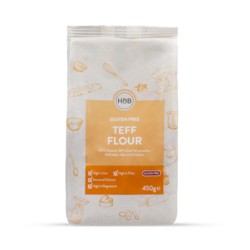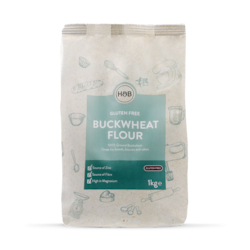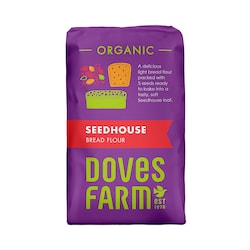20% off £30
Gluten free flour – the basics

Are you a passionate baker with gluten sensitivity or coeliac disease? Or is a friend, colleague or loved one on a gluten free diet and you want to cater for their needs?
Luckily, gluten free flours are becoming more widely available to meet increasing demand in the UK and there are countless innovative ways to combine them to produce delicious baked goods.
In this article, you’ll find out:
- What gluten is
- What is in gluten free flour
- What flour is gluten free
- The best types of gluten free flour for baking, pasta, bread and pancakes
- How gluten free flour is used
What is gluten?
Before delving into the details about gluten-free flour, it’s important to be aware of what gluten actually is.
A form of protein found in grains such as wheat and to a lesser extent, barley and rye, gluten goes sticky when water is added, which creates a gluey substance which, with more mixing, transforms into a stretchy, pillow-y dough.1
When combined with yeast and baked under high heat, the gluten in the bake forms tiny gas pockets, which inflate and harden. This is what gives bread, cakes and pie crusts their structure.
Is all flour gluten free?
No, not all flour is gluten free which is why it’s key to understand which types of flour do and don’t contain gluten – especially for those with an intolerance or allergy.
The most common type of flour that contains gluten and is often used in lots of commercial baked goods, is wheat flour. However, it can also be found in flours that use rye, barely, spelt and triticale.2
What is gluten free flour? And what is it made from?
So, what is gluten free flour? Various gluten free plants, vegetables and nuts can be ground or milled to make flour.
In gluten free baking, a blend of more than one type of flour, including a binding agent, is usually preferable than using it alone. This helps to better mimic the desirable structure, texture and bite that gluten provides.
The sticky, binding properties of gluten can be recreated using a high-protein flour such as quinoa flour. Alternately, you could use a small amount of xanthan gum to achieve the sticky gluten-like effect.3
Another tip is to use a small amount of tapioca flour in your blend. Tapioca flour is made from the cassava plant root and creates a thick, gluey texture which acts as a binding agent.
Summary
- Gluten is a type of protein found in grains including wheat, barely and rye
- Not all flour is gluten free
- Gluten free flour can be made from a range of plant-based ingredients and is often used with a binding agent to achieve a gluten-like effect
What flour is gluten free?
Whether you’re looking to bake your own cakes or bread without using any gluten or you just want to find out some more alternatives, there are plenty of different types of gluten free flours to try.
Here are some of the most popular alternatives to wheat flour:
-
Buckwheat flour
Not technically a wheat, despite the name. Buckwheat brings a wholesome, rustic flavour to muffins and pastry. Try our Almond, buckwheat & manuka honey pancakes recipe, made with buckwheat flour.
In 100g of buckwheat flour, there’s approximately 335 calories, 12.6g of protein, 70.6g of carbohydrates and 10g of fibre.4
In addition to this, buckwheat also contains an array of B vitamins with 0.582mg of vitamin B-12 in 100g, as well as 4.0mg of iron, 54µg of folate and 251mg of magnesium.4
-
Potato flour
Made from potato starch. Potato flour can be used in bakes which call for a denser texture, such as pancakes or flatbreads. But it can also be used in homemade sauces and gluten free batters too!
100g of potato flour provides approximately 357 calories, 6.9g of protein, 83.1g of carbohydrates and 5.9g of fibre.5
-
White or brown rice flour
Full of fibre, white or brown rice flour is best blended with other gluten free flours to avoid a dense bake. Great for pancakes or muffins. This Pomegranate & Orange Drizzle Cake uses half rice flour, half buckwheat in the recipe – so why not give it a go?
In 100g of brown rice flour, there’s approximately 363 calories, 7.23g of protein, 76.5g of carbohydrates and 5.6g of fibre.6
In 100g of white rice flour, there’s approximately 359 calories, 6.94g of protein, 79.8g of carbohydrates and 0.5g of fibre.7
-
Nut flour
One of the most popular types of gluten free flour, almond or cashew flour can be added to another gluten free flour blend for use in almond flour cake, cookies, macarons, brownies and biscuits.
In terms of nutritional information, 100g of almond flour contains approximately 576 calories, 21.4g of protein, 21.4g of carbohydrates and 12.5g of fibre.8 Making it a great choice if you’re trying to up your protein intake.
If you’re more interested in using cashew flour instead, 100g contains approximately 364 calories, 10.4g of protein, 76g of carbohydrates and 2.7g of fibre.9
-
Corn flour
Primarily known for thickening sauces and gravy, corn flour is actually another great gluten free flour alternative. Corn flour is made from the starchy centre of corn kernels and can also be used in cakes and pastry.
In 100g of corn flour, there’s approximately 363 calories, 8.46g of protein, 76.6g of carbohydrates and 6.4g of fibre.10
-
Maize flour
You might be wondering, is maize flour gluten free? Made from whole corn kernels, maize flour is one of the best gluten free flours for making your own tortillas, shortcrust pastry, biscuits and US-style cornbread.
Sound like the sort of recipes you’d like to try? Learn to make gluten free pastry today!
100g of maize flour provides approximately 364 calories, 8.75g of protein, 73.9g of carbohydrates and 8.4g of fibre.11
-
Coconut flour
Made from dried and ground coconut meat, coconut flour is perfect for sweet bakes as it imparts a strong coconutty flavour.
Whether you use it in cakes, cookies or brownies – coconut flour actually comes packed with a variety of nutrients – namely protein and fibre.
In 100g of coconut flour, there’s approximately 456 calories, 19.2g of protein, 54g of carbohydrates and 9.1g of fibre.12
So if you’re looking for a lower carb option, coconut flour could be one to consider for your bakes.
-
Soya flour
Made from toasted, finely crushed soya beans, soya flour works well for thickening sauces, making flatbreads and pizza bases – so this is a great one to try for savoury recipes.
100g of soya flour contains approximately 565 calories, 9.86g of protein and 50.6g of carbohydrates.13
-
Quinoa flour
High in protein and fibre, the seeds of the quinoa plant are ground to make a fine flour, which you can substitute for wheat flour in recipes. Ideal for pizza bases, flatbreads and savoury pancakes.
In 100g of quinoa flour, there’s approximately 370 calories, 14.4g of protein, 64.8g of carbohydrates and 7g of fibre.14
-
Oat flour
Easy to make yourself or simply buy readymade, oat flour is another great swap for regular flour that doesn’t contain gluten.
However, there are a couple of things to be aware of. While oats themselves don’t contain any gluten, there is a risk that they may become contaminated with other cereals that do contain gluten.15
So if you do decide to make your own, be sure to use oats that are already clearly labelled gluten free.
100g of oat flour contains approximately 404 calories, 14.7g of protein, 65.7g of carbohydrates and 6.5g of fibre.15
-
Chickpea flour
Also known as gram flour or garbanzo flour, chickpea flour is another excellent replacement for wheat flour.
Made by grinding dried chickpeas, this is a very popular choice of flour in the Indian and Middle Eastern cuisine and is used to make popular dishes like falafel and flatbread.
In 100g of chickpea flour, there’s approximately 387 calories, 22.4g of protein, 57.8g of carbohydrates and 10.8g of fibre.16
So if you’re looking to add more fibre into your diet, it might be worth using chickpea flour in some more of your dishes!
-
Sorghum flour
Made from an ancient grains dating back 5,000 years, sorghum flour is another popular replacement for wheat flour. High in both protein and fibre, this dense yet mildly flavoured gluten free alternative is great for cookies, brownies and sourdough recipes.
In 100g of sorghum flour there’s approximately 347 calories, 8g of protein, 74.4g of carbohydrates and 6.4g of fibre.17
-
Teff flour
Typically used in Ethiopian cuisine, teff flour has been used for a variety of foods such as bread, cereals, pancakes and snacks – and is naturally gluten free. What’s more, like sorghum flour, teff flour is also a great source of fibre and protein too!
100g of teff flour contains approximately 352 calories, 12.6g of protein, 70.2g of carbohydrates and 7.8g of fibre.18
-
Amaranth flour
Another ancient grain like buckwheat, amaranth flour can be used to replace some of the regular wheat flour in a traditional recipe. With a mild, nutty flavour, amaranth flour can be used in a range of sweet and savoury recipes.
In 100g, Amaranth flour has approximately 388 calories, 14.4g of protein, 63.2g of carbohydrates and 6.2g of fibre.19
-
Tigernut flour
Originating from North Africa and parts of the Mediterranean, tigernut flour comes from a small root vegetable – despite the misleading name. And with a naturally sweet, nutty flavour, you won’t need to add quite as much sugar to your baked goods!
100g of tigernut flour contains approximately 480 calories, 6.4g of protein, 60.8g of carbohydrates and 32g of fibre.20
-
Cassava flour
Also referred to as yuca, cassava flour comes from the South African cassava root vegetable, where it is dried and grated to create the flour.
Great for replacing plain flour in traditional recipes, cassava flour has a subtle, neutral flavour meaning it can be used in a variety of sweet and savoury dishes.
In 100g of cassava flour, there’s approximately 182 calories, 1.6g of protein, 43.2g of carbohydrates and 2g of fibre.21
Gluten free flour examples
-
Gluten free flour for bread
For bread, an excellent combination would be rice, potato, tapioca, maize and buckwheat to give an all-purpose blend as an alternative to wheat flour that behaves in a similar way. You can blend your own - or buy ready-blended versions.
Handpicked content: How to choose the right gluten-free bread
-
Gluten free flour for baking
If you plan on baking gluten free foods regularly, it’s a good idea to build a store cupboard of different gluten free flours, in order to create personalised blends according to what different recipes require.
-
Gluten free flour for pasta
Fancy making your own gluten free pasta? You’re in luck. You can make a range of delicious tasting pasta with the wheat flour alternatives listed above. Some top picks include: almond flour, chickpea flour and brown rice flour.
-
Gluten free flour for pancakes
A Sunday morning classic, being gluten free doesn’t mean that you have to give up pancakes. In fact, there are a selection of gluten free pancake flours that are perfect for the job. Namely, potato flour, brown rice flour, quinoa flour and teff flour – so it’s time to get that whisk up and running again!
Is gluten free flour used the same as regular flour?
So now you know all about the different types of gluten free flour, how do you actually use them? And can you use them in the same way as regular flour?
Providing you have the right quantities for a good bake, gluten free flour can be used in the same kinds of recipes as regular flour – but you may need to add a binding agent like xanthan gum or tapioca!
Can I use gluten free flour in place of regular flour?
Unfortunately, there’s no universal answer to this question. With some you can and some you can’t, as you may need some extra ingredients.
However, you can use pre-mixed gluten free flour (often using the ingredients we’ve listed in this article) that has all already considered the binding agent as a straight swap for regular flour.
The final say
- Not all flour is gluten free
- There are a range of gluten free flour alternatives that you can mix yourself or buy pre-mixed
- Different types are better for different recipes, so be sure to find the right swap
- Gluten free flour can be used to replace regular flour in a lot of recipes, but you may need a couple of extra ingredients to get it right
- https://celiac.org/gluten-free-living/what-is-gluten/
- https://celiac.org/gluten-free-living/what-is-gluten/sources-of-gluten/
- https://www.coeliac.org.uk/information-and-support/your-gluten-free-hub/home-of-gluten-free-recipes/new-to-gluten-free-cooking/gluten-free-cake-making/
- https://fdc.nal.usda.gov/fdc-app.html#/food-details/170687/nutrients
- https://fdc.nal.usda.gov/fdc-app.html#/food-details/168446/nutrients
- https://fdc.nal.usda.gov/fdc-app.html#/food-details/168446/nutrients
- https://fdc.nal.usda.gov/fdc-app.html#/food-details/790214/nutrients
- https://www.nutritionix.com/food/almond-flour
- https://www.nutritionix.com/food/cashew-flour
- https://fdc.nal.usda.gov/fdc-app.html#/food-details/169694/nutrients
- https://fdc.nal.usda.gov/fdc-app.html#/food-details/168921/nutrients
- https://www.nutritionix.com/food/coconut-flour
- https://fdc.nal.usda.gov/fdc-app.html#/food-details/410156/nutrients
- https://www.nutritionix.com/food/quinoa-flour
- https://www.nhs.uk/conditions/coeliac-disease/treatment/
- https://fdc.nal.usda.gov/fdc-app.html#/food-details/174288/nutrients
- https://www.nutritionix.com/food/sorghum-flour
- https://www.nutritionix.com/food/teff-flour
- https://www.nutritionix.com/food/amaranth-flour
- https://www.nutritionix.com/food/tigernut-flour
- https://www.nutritionix.com/food/cassava-flour



































